
Corsair Obsidian 250D Review
Manufacturer: CorsairUK Price (as reviewed): £71.99 (inc. VAT)
US Price (as reviewed): $89.99 (ex. TAX)
With every other popular case manufacturer we can think of sporting some sort of mini-ITX offering, we've been wondering for a while why Corsair hasn't added the dinky form factor to its extensive list of cases. Its flagship Obsidian 900D case made us even more curious seeing as it filled the only other slot that Corsair had to fill - a super high-end water cooling case - and that was nearly a year ago.
So it's fair to say Corsair is somewhat late to the party with its offering, the Corsair 250D. And this poses somewhat of a dilemma; how to create something that can compete with the likes of the BitFenix Prodigy and Phenom, EVGA Hadron Air and Cooler Master Elite 130 Advanced?
The solution is quite simple. Listen to what people liked and didn't like about those cases and pile all this information in to your design. Of course, that's easier said than done. We're talking about the proposed case offering good water-cooling support along with good air cooling like the Prodigy, while being small and compact like the Hadron Air, while sporting good looks like the Phenom but finding a balance between size, ease of use and support for high-end hardware like the Elite 130 Advanced. Not a tall order then.
Click to enlarge
So, today we're looking at what Corsair has come up with. We honestly weren't sure which of Corsair's numerous case lines it would fall under - the edgy Graphite series or the premium Obsidian series - but Corsair has chosen its high-end line to debut its first mini-ITX case, giving us the Corsair Obsidian 250D. This follows on nicely, of course, from the micro-ATX Corsair Obsidian 350D but the latter's new smaller sibling looks far less bland and far more interesting, especially with a price tag of just £72.
Click to enlarge
Size-wise, if the Prodigy was too big for you, then the 250D's smaller height and depth will be right up your street (the 250D is over 11cm shorter and a shallower too). It is a wide case though - at 28cm it's a good 3cm wider than the Prodigy. However, that's to be expected given that this is more of a cube case than a tower like the Prodigy and Hadron Air.
Click to enlarge
However, it's by far the biggest mini-ITX cube-style case we've reviewed and the interior, which we'll look into over the page, is very different to other cases we've looked at too. the exterior, though, feels very well made, and the roof and both side panels are standard slide-in affairs and are made of individual steel panels. One of these sports a huge vent over the GPU area, while it's opposite number does the same for the 250D's side fan mounts. Thankfully, the roof section does include a window and to be honest, Corsair has absolutely done the right thing here and provided a small but adequate view of the interior but focused more on cooling.
In fact, while the case is certainly elegant and well thought-out in several ways, cooling does appear to the main focus. The front panel sports an external 5.25in bay - still useful for fan controllers and bay reservoirs even if not for an optical drive - but beneath it sits a huge (considering the small size of the 250D) pop-down panel that reveals an equally gargantuan removable fan filter and accompanying 140mm fan (it can also fit up to 200mm fans). It's an interesting design that has the potential to offer a good balance of cooling and low noise, as the front panel sits a good 20mm away from the recessed front of the case, meaning air can be drawn in through substantial gaps round the edge.
Click to enlarge
The front section also plays host to the usual two USB 3.0 ports and 3.5mm headphone and microphone jacks, while the power button actually sits to the top left of the 5.25in bay. Beneath this sits a tiny reset button that looks pretty immune to accidental presses. The underside doesn't offer too many exiting features except for rubber feet and a PSU dust filter, while the rear gives you some idea of the unique layout Corsair has chosen.
Click to enlarge
The full-size PSU mount is located at the rear beneath the motherboard, not unlike the arrangement in the Prodigy, while to its left sits a bunch of storage mounts. The motherboard sits horizontally - again like the Prodigy, with two PCI expansion slots and two rear 80mm fan mounts, neither of which are occupied out of the box.
Specifications
- Dimensions (mm) 277 x 351 x 290 (W x D x H)
- Material Steel
- Available colours Black
- Weight 6kg
- Front panel Power, reset, 2 x USB 3, stereo, microphone,
- Drive bays 2 x 3.5in, 2 x 2.5in, 5.25in external
- Form factor(s) Mini-ITX
- Cooling 1 x 120/140/200mm front fan mount (1 x 140mm fan included), 2 x 120mm rear fan mounts (1 x 120mm fan included) 2 x rear 80mm fan mounts (fans not included)
- CPU cooler clearance 95mm with optical drive installed
- Maximum graphics card length 290mm dual-slot
- Maximum PSU length 270mm
- Extras front and PSU fan filters

MSI MPG Velox 100R Chassis Review
October 14 2021 | 15:04


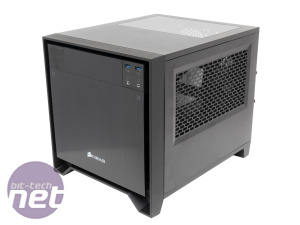
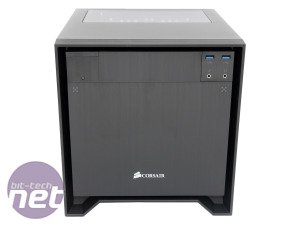
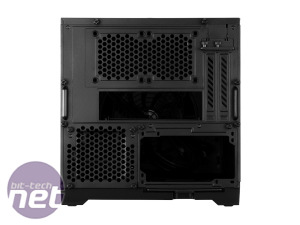
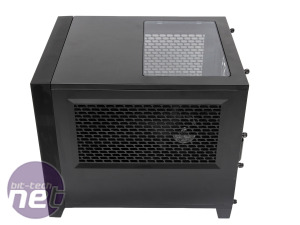
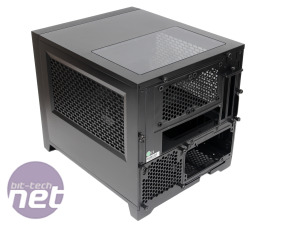
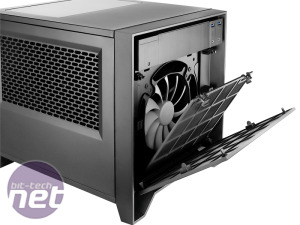
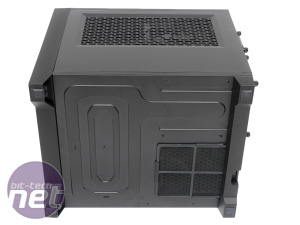
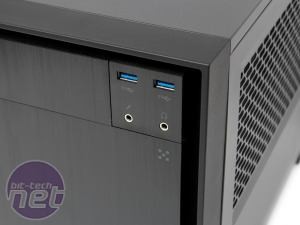

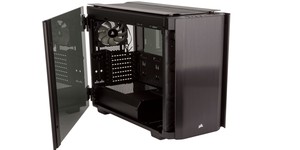






Want to comment? Please log in.